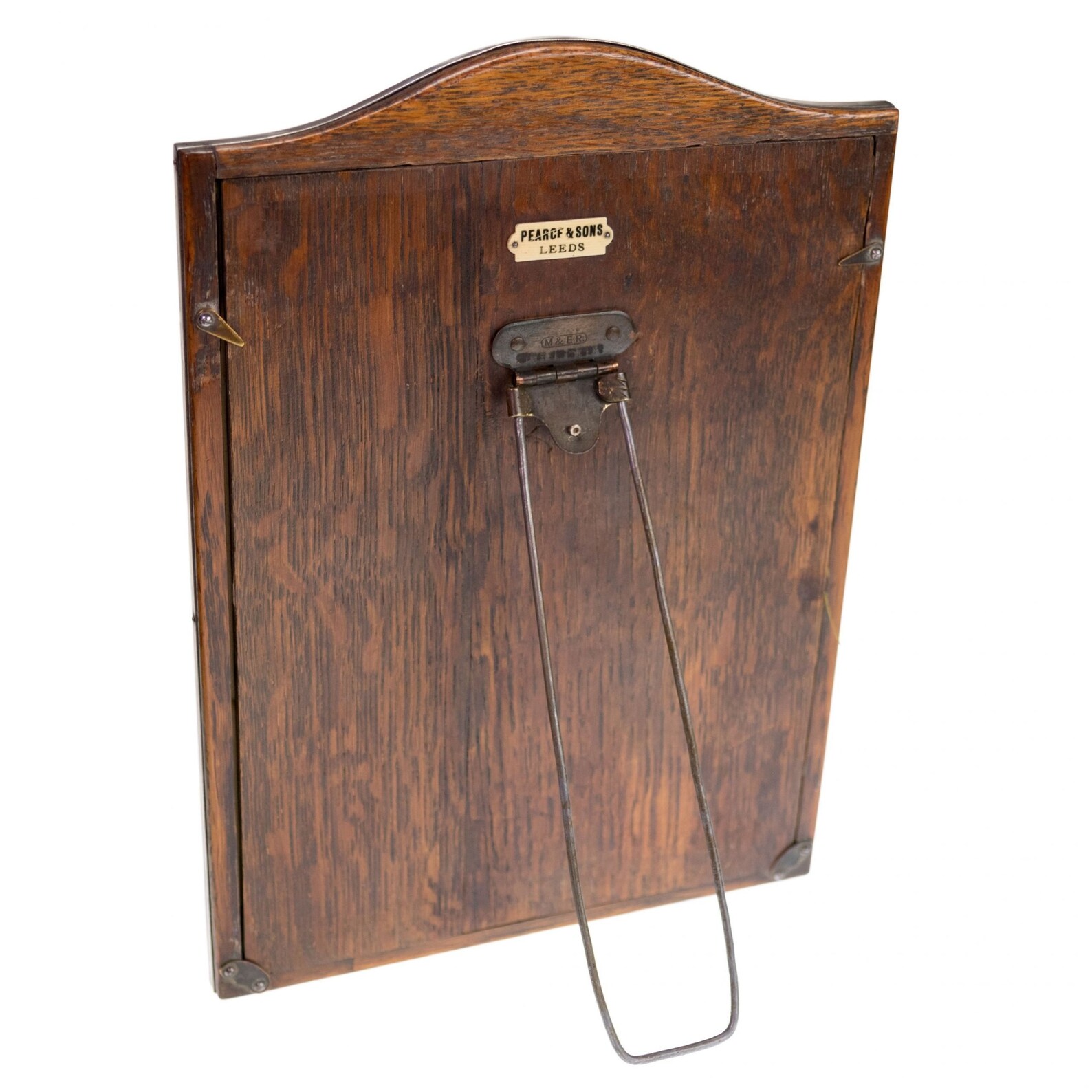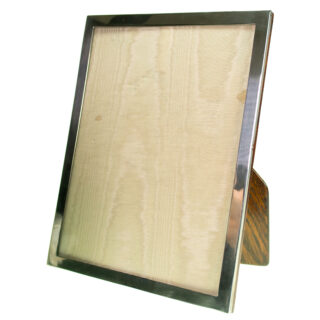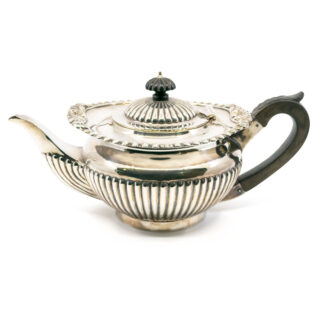This charming antique photo frame, created by E. Mander & Son, features a hallmarked 925 silver border paired with a sturdy wooden back. Produced in Birmingham in 1923, its elegant curves and detailed silverwork make it an exquisite showcase for treasured photographs, blending practicality with historical beauty.
Videos
Details: Silver Frame.
Dimensions: 24.5 x L 17,5cm (entire frame), 20,3 x 15,2cm (internal window).
Weight in grams: 366.
Condition: Good condition – used with some signs of wear.
Shipping and Pickup: This lovely piece ships from our store located in the center of Amsterdam, The Netherlands. We offer both registered shipping and local pickup at our store. In the case of local pickup, any applicable shipping costs will be refunded.
About Us: Add some sparkle to your style with Binenbaum.com. We offer a stunning selection of antique and vintage jewelry that you won’t find anywhere else. From timeless rings and dazzling necklaces to unique brooches, we have something for every taste and occasion. Visit our website today and treat yourself to a piece of history.
| Design Era | |
|---|---|
| Design & Historical Context | Art Nouveau, also known as the Modern Style or or Jugendstil, is a decorative art movement that emerged in the late 19th century and was popular until World War I. It is characterized by its use of flowing, organic lines and naturalistic motifs, such as flowers, plants, and animals, as well as its emphasis on craftsmanship and the use of unconventional materials, such as glass, ceramic, and metal. Art Nouveau jewelry often features intricate and detailed designs, with a focus on curved lines and natural forms. The jewelry is often made of precious metals, such as gold and silver, and may be adorned with gemstones, enamels, and other decorative elements. One of the most distinctive features of Art Nouveau jewelry is its use of elongated, sinuous lines and flowing, organic shapes, which were meant to evoke a sense of movement and fluidity. The jewelry often depicts nature themes, such as flowers, vines, and leaves, as well as abstract and symbolic motifs, such as the female form, which was often depicted in a sensual or romanticized way. Art Nouveau jewelry was popular in many countries, including France, Belgium, Austria, and the United States, and was produced by a wide range of designers and artists, including Louis Comfort Tiffany, René Lalique, and Gustav Klimt. Despite the popularity of Art Nouveau, the movement eventually fell out of favor after World War I, and was replaced by more geometric and industrial styles. However, it has often been revived and continues to influence contemporary jewelry design. |
| Materials & Craftsmanship | Silver: The Metal of Elegance and Versatility Silver, known for its bright, reflective luster, is one of the most beloved and widely used precious metals in the world. This versatile metal has been cherished for thousands of years, not only for its beauty but also for its malleability, making it ideal for crafting intricate and delicate jewelry designs. Historically, silver has been associated with the moon and considered a symbol of purity, clarity, and protection. Ancient civilizations, from the Egyptians to the Greeks and Romans, valued silver for its beauty and used it to create coins, jewelry, and religious artifacts. In many cultures, silver is also believed to have healing properties, often used in amulets and talismans to ward off negative energy. In modern jewelry, silver is prized for its affordability, versatility, and timeless appeal. Sterling silver, an alloy of 92.5% pure silver and 7.5% other metals (usually copper), is the standard used in high-quality jewelry. Its durability and bright, reflective surface make it an excellent choice for a wide range of designs, from minimalist pieces to ornate creations. Silver can be polished to a high shine or given a matte, oxidized, or antiqued finish to suit various styles. Silver is more than just a metal; it is a symbol of elegance, flexibility, and understated luxury. Its enduring popularity and wide-ranging applications make it a staple in jewelry that can complement any look, from casual to formal, with timeless grace. |
| Dimensions | 24.5 x L 17,5cm (entire frame), 20,3 x 15,2cm (internal window) |
| Gender | |
| Weight (in grams) | 366 |
| Condition |
Enhance the Beauty of Your Jewelry with Proper Care
Wearing your jewelry is a special way to express yourself and add a touch of personal style to any look. However, to ensure your jewelry remains in pristine condition, there are a few simple steps you need to take to keep it looking its best.
General Care Instructions:
Remove jewelry when showering or bathing, especially when at the beach, in the sea or in chlorinated water.
Avoid wearing jewelry while doing physical work such as housekeeping, gardening or exercise.
Storing your jewelry in a dry and cool place will help protect it from moisture, dirt and dust.
Keeping it away from harsh chemicals such as bleach, ammonia and chlorine will help to avoid discoloration and damage.
Cleaning your jewelry regularly with a soft cloth will help to keep it looking shiny and new.
Avoid exposing your jewelry to extreme temperatures, such as leaving it in direct sunlight or near a heater, as this can cause damage.
Handle your jewelry carefully and avoid dropping it, as this can cause the stones to loosen or the metals to scratch.
Finally, if possible, have your jewelry professionally checked and serviced. This will ensure that any potential problems are spotted and fixed before they become worse.
By following these tips, you can enjoy your precious jewelry for many years to come.
Related Products
-
Silver Antique Frame 1373-1807
€ 1.295,00 VAT incl. (where applicable) -
Diamond 18k Silver Antique Ring 11144-0107
€ 2.895,00 VAT incl. (where applicable) -
Aquamarine Diamond 18k Silver Antique Ring 3632-1719
€ 1.695,00 VAT incl. (where applicable) -
Silver Antique Sugar Castor 12724-2898
€ 1.495,00 VAT incl. (where applicable) -
Silver Antique Bell 15209-3096
€ 295,00 VAT incl. (where applicable) -
Silver Antique Tea Pot 856-2147
€ 1.995,00 VAT incl. (where applicable) -
Diamond 14k Silver Antique Ring 7311-0718
€ 1.695,00 VAT incl. (where applicable) -
Silver Antique Hip Flask 8990-2646
€ 995,00 VAT incl. (where applicable)
- Home
- Collection
- Fine Jewelry
- Silver Jewelry
- Silverware
- Boxes
- Candlesticks
- Salt and pepper shakers
- Miniatures
- Salt cellars
- Spoon Set
- Condiments
- Frames
- Napkin Ring
- Spoon
- Oddities
- Cups
- Vases
- Cutlery
- Serving Spoon And Cake Server
- Candlesticks
- Baskets
- Hanukkiah
- Spice Tower
- Yad
- Tea Set
- Sugar Castor
- Napkin Rings
- Wine Bottle Coaster
- Wine Stopper
- Tea Pot
- Jugs
- Rattles
- Hip Flask
- Miscellaneous
- Rings 💍
- About
- Contact






















